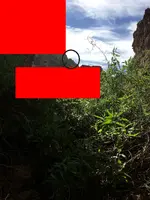For all that want a fuller understanding of the "Pit Mine" and its history there is quite a bit of information available on line (in this forum and elsewhere). One thing very important to understanding the evolution of the Pit Mine is to understand Ted Cox, what he believed and what he did. That's no small order <g>.
But before we get there, lets back track for a moment. I'd recommend you read Herman's interview shortly (very shortly) before his death. Why Herman? Because he's the closest source we have that documents what Waltz really said. Even he is a second hand source. But he's the closest we have (in my opinion). In that interview (and other talks at that time) He looks to the north and points to the Iron Mountain area and tells us many old Spanish mines are located there, Three of which were known to Jacob Waltz. He mentions their names as the El Sombrero, a mostly worked out digging, and The Quartzer and The Placer. Waltz worked the Quartzer and The Placer.
My personal belief is the Quartzer and Placer are the two primary mines discussed in most clues we research today. Geographically they all lay on the same basic fault line or volcanic event. The El Sombrero lying further west than the other two and with the Quartzer and Placer being further east. And; those two being somewhat closer together. The Quartzer first and the Placer being the most eastern one and across canyon and a little north of the Quartzer. My guess (for what its worth) is the Quartzer is the same mine we know today as The Pit Mine. The Quartzer was a dug deposit deeper (but not very deep) on the same ledge, and the Placer was a surface outcrop where the ledge met the surface (not too deep at all).
Other sources dovetail very well with these stories and the possible location of the mines. All "Peralta" legends speak of them working two mines in this area, in close proximity, and of the same general description. This is the description Adolph Ruth had which was told to his son, Erwin Ruth, by his Mexican sources. And this is the same story told by John Reed. Of course there are holes in John Reed's story as big as Texas. If you can believe any of it, it always speaks of two rich sites, both difficult to find, worked originally by the Mexican miners. One a dug mine the other a more surface type. You can read John Reed's personal letters describing the mines and telling his story in Garry Cudliff's pages under The Adolph Ruth Story - Eleanor Clark collection. Its fascinating. Its my opinion all of John Reed and his father's interaction with Jacob Waltz (if that really happened) took place at The Quartzer. My personal opinion is John Reed was recounting stores of such encounters told by his father (and embellished) and he personally never laid eyes on Jacob Waltz, I could be wrong. John Reed's father looked for but never found the Placer.
The Roger's District silver strike took place in the mid 1870's. After Waltz had retired from active mining (in my opinion). Any late in life trips by Waltz was for retrieval of caches (in my opinion). Just my thoughts.
You can read a very descriptive account of the Roger's mine, the Silver Chief, era 1875 here.
https://books.google.com/books?id=U...r's mining district silver chief 1875&f=false
Does that sound like the same "Silver Chief" later claimed by Abby Hatch in 1910? Not to me, but to each, their own to decide. The Abby Hatch Silver Chief (1,2, 3 etc) (I believe) are the mines depicted on the Jack Carlson/Jack San Falise maps. I very well could be wrong on that too. I'm just telling you what I think. I don't have copies of what was originally filed in the 1875 era but I do have the 1910 filings. It should be noted Abby Hatch filed as a new find location, not a refiling on an existing mine. Small point, and I don't know squat about filing for claims. But I have seen filings where existing mines were reopened as a re-filing, not a new location, over and over again in the records. If this was the "original" Roger's Silver Chief why wasn't this filed as a re-filing on an existing mine

Something to ponder.
Fast forward to Ted Cox. Interesting man, with an interesting history. Matthew Roberts wrote an excellent piece on him which can be found in this forum under the thread title "Ted Cox and the Ridge Pit Mine". Ted Cox wasn't just a "come-here" dutch hunter. He was raised with a Mexican influence, I would suppose he spoke the language fluently and understood the culture. His father was a miner and lost mine hunter before him. He knew the area well and spent a good part of his life exploring it in and out of old pits. I don't totally discount all that he wrote and thought just because he lead a life on the edge of society. If that's a reason to throw out all he said and thought we'd have to throw out most of what we know from ALL sources associated with this legend <g>.
Ted Cox left a very detailed account of his theory, findings and a map in his diary. That map depicts both the Quartz and the Placer deposits. If you want to know why current day folks (not to be named) dug where they did and found what they did, you need look no further than the Ted Cox diary and map. What it shows and where its located is in total harmony with history handed down since the Mexican miners first put pick to rock.












 Something to ponder.
Something to ponder. 
